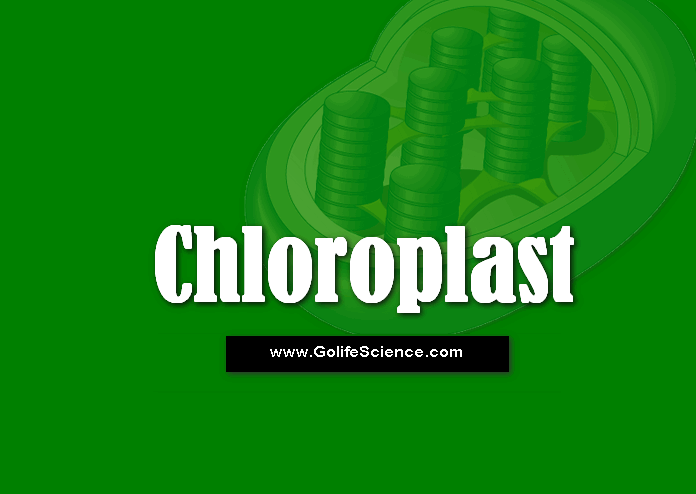
The chloroplast is the green plastid in land plants, algae, and some protists. Chloroplasts are found in all green plans and in some blue green algae.
As the site in the cell where photosynthesis takes place, chloroplasts are responsible for much of the world’s primary productivity, making chloroplasts essential to the lives of plants and animals alike.

Chloroplast Definition
“Chloroplast is an organelle that contains the photosynthetic pigment chlorophyll that captures sunlight and converts it into useful energy, thereby, releasing oxygen from water. “
Agriculture, animal farming, and fossil fuels such as coal and oil are all “products” of photosynthesis that took place in chloroplasts.
Other important activities that occur in chloroplasts (and several non-photosynthetic plastid types) include the production of starch, certain amino acids and lipids, some of the colorful pigments in flowers, and some key aspects of sulfur and nitrogen metabolism.
- In 1883 “Schimper” first used the term “Plastid” for special cytoplasmic organelles present in eukaryotic plant cells.
- The common name of the chloroplast is “Natural Pressure Cookers”.
- All eukaryotic organelles with photosynthetic capabilities have chlorophyll-containing organelles called “Chloroplasts”.
- Chloroplast organelles are “Semi-Autonomous organelles”.
- In addition to chloroplasts, other colored plastids may be observed. (Chromoplats).
- In a green leaf, a single palisade cell contains approximately 40 chloroplasts. Each chloroplast is about 5 to 10µm in diameter and about 2 to 3 µm thick.
- Chloroplasts, like mitochondria, are very special organelles; these are formed from pre-existing organelles.

Chloroplast Structure
Chloroplasts have a heterogeneous structure made up of small granules called “Grana”, which are embedded within the stroma (or) Matrix.

a) Envelope:
- It is made of a double limiting membrane across which the molecular interchange with the cytosol occurs.
b) Stroma:
- It fills most of the volume of the chloroplast and is a kind of gel-fluid phase that surrounds the thylakoids.
- It contains about 50% of chloroplast proteins & most of these are of the soluble type.
- It has ribosomes & also DNA; both of which are involved in the synthesis of some of the structural proteins of the chloroplast.
- The stroma is where CO2 fixation occurs & where the synthesis of sugars, starch, fatty acids & some proteins takes place.
c) Thylakoids:
- It consists of flattened vesicles arranged as a membranous network.
- The outer surface is in contact with the stroma, and its inner surface encloses an “intra-thylakoid space”.
- Thylakoids may be stacked like a pile of coins, forming the “Grana” (or) they may be unstacked (stroma thylakoids), forming a system of anastomosing tubules that are joined to the grana thylakoids.
- The number of thylakoids varies from a few to 50 (or) more.
Chloroplast of Chlamydomonas is cup shaped. In Chlamydomonas, chloroplast is single and cup-shaped. Chloroplasts are the pigment (chl-a and chl-b) containing bodies present in green algae. The green colouration of the members of chlorophyta is due to the presence of excess of chlorophyll in the chloroplasts. The chloroplasts are well defined bodies met within every cell of the members of this class, though number and shape of the chloroplasts varies in different orders of the class.
Molecular Organization of Thylakoids
The Molecular organization is largely based on the fluid lipid-protein mosaic model of the membrane proposed by “Singer” and “Nicolson” in 1972.
This basic concept includes several fundamental properties like fluidity, Asymmetry, Economy. The thylakoid membranes have chlorophylls, carotenoids, Plastoquinones.
There are also structural lipids, which are mainly Glycoproteins, Sulpholipids & a few phospholipids.
Most of the structural lipids are highly unsaturated, which confers to the thylakoid membrane a high degree of fluidity.
Functions of Chloroplast
Here is the basic chloroplast functions:
- The major function of chloroplast is to synthesize the food by utilizing carbon dioxide and water in the presence of sunlight
- It converts light energy into chemical energy
- Chloroplast has a green pigment called “Chlorophyll”. this pigment traps solar energy and is used for food synthesis.
- It produces NADPH and molecular oxygen by the process of photolysis of water
- It produces ATP.
- In the Calvin cycle or dark reaction of photosynthesis, it produces carbon and sugar in the process of Calvin cycle by using Carbon dioxide which comes from outside.
Frequently Asked Questions (FAQs)
Reference: Read for more
Where does the photosynthesis process occur in the plant cell?
In all green plants, photosynthesis takes place within the thylakoid membrane of the Chloroplast.
List out the different parts of Chloroplast?
Chloroplasts are cell organelles present only in a plant cell and it includes: Stroma, Inner membrane, Outer membrane, Thylakoid membrane, and Intermembrane Space.
What is the most important function of chloroplast?
The most important function of chloroplast is the production of food by the process of photosynthesis.
Why is the chloroplast green?
The chloroplasts contains a green pigment called Chlorophyll. This pigment gives green color to all the green plant.
How many types of plastids are there?
Three types of plastids are existed. they are chloroplast, chromoplast and leucoplast.

